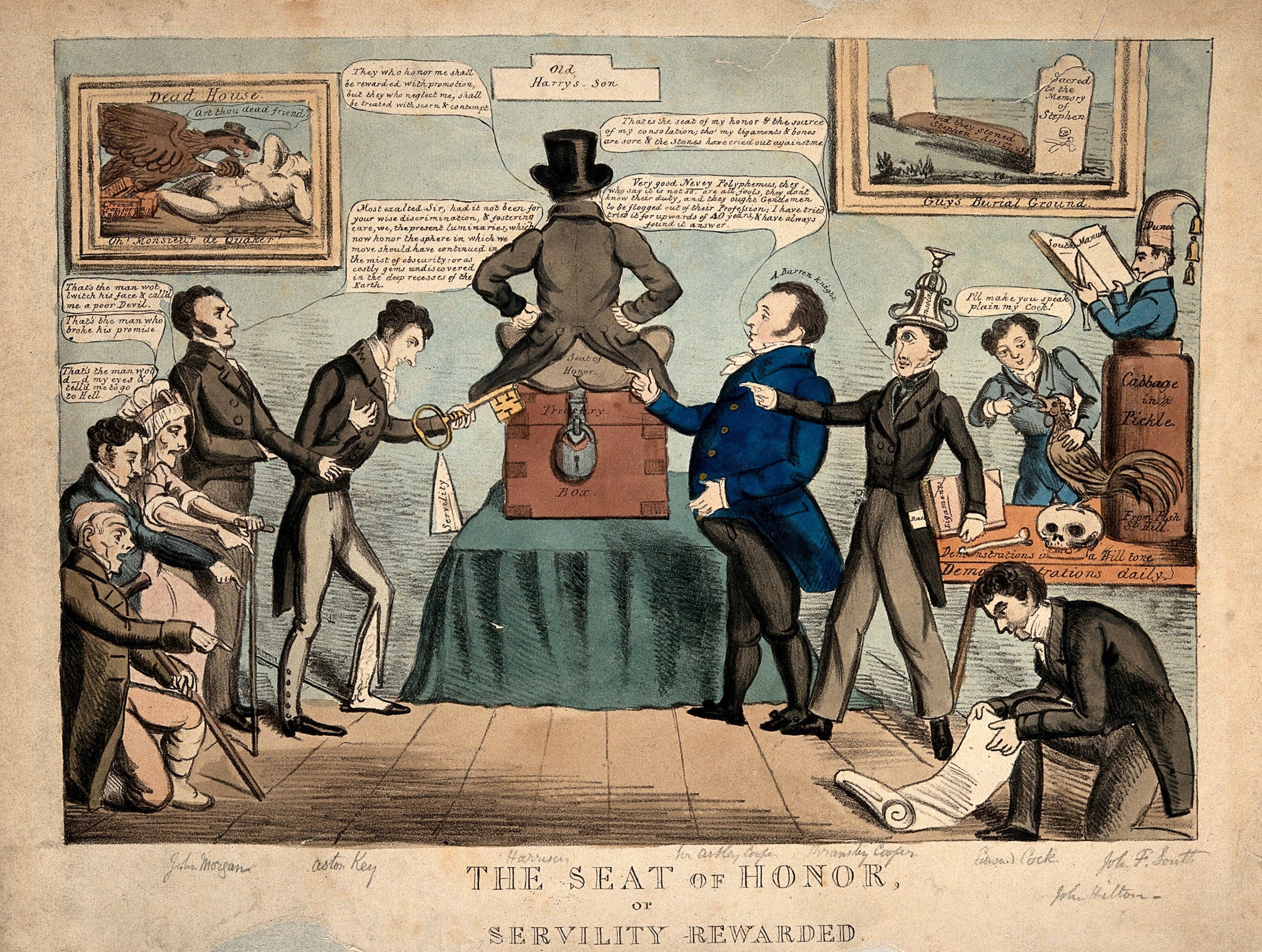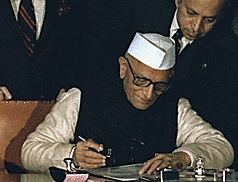|
Aaya Ram Gaya Ram
Aaya Ram Gaya Ram ( en, Ram has come, Ram has gone) expression in politics of India means the frequent floor-crossing, turncoating, switching parties and political horse trading in the legislature by the elected politicians and political parties. The term originated in 1967 in Haryana where excessive political horse trading, counter horse trading and counter-counter horse trading took place; triggering several rounds of frequent political defections by the serial-turncoat politicians within a span of few weeks; resulting in the dissolution of the Haryana Legislative Assembly and consequently the fresh elections were held in 1968. It became the subject of numerous jokes and cartoons. After 1967, several parties in India often continued to be involved in this type of political horse-trading to grab the power. To end this trend, the anti-defection law was made in 1985. The trend still continues to surface every now and then,Paras Diwan, 1979, "Aya Ram Gaya Ram: The Politics Of Def ... [...More Info...] [...Related Items...] OR: [Wikipedia] [Google] [Baidu] |
Crossing The Floor
In parliamentary systems, politicians are said to cross the floor if they formally change their political affiliation to a different political party than which they were initially elected under (as is the case in Canada and the United Kingdom). In Australia though, this term simply refers to Members of Parliament (MPs) who dissent from the party line and vote against the express instructions of the party whip while retaining membership in their political party (at least for the time being). Voting against party lines may lead to consequences such as losing a position (e.g., as minister or a portfolio critic) or being ejected from the party caucus. While these practices are legally permissible in most countries, crossing the floor can lead to controversy and media attention. Some countries like India, the Maldives and Bangladesh have laws that remove a member from parliament due to floor-crossing. Etymology The term originates from the British House of Commons, which is config ... [...More Info...] [...Related Items...] OR: [Wikipedia] [Google] [Baidu] |
Hodal (Vidhan Sabha Constituency)
Hodal Assembly constituency is one of the 90 Legislative Assembly constituencies of Haryana state in India. It is part of Palwal district and is reserved for candidates belonging to the Scheduled Castes. Members of the Legislative Assembly Election results 2019 See also * List of constituencies of the Haryana Legislative Assembly The Haryana Legislative Assembly is the unicameral state legislature of Haryana state in India. The seat of the Legislative Assembly is at Secretariat Building in Chandigarh, the capital of the state. The term of the Legislative Assembly ... * Palwal district References {{coord, 27.89, 77.37, display=title Palwal district Assembly constituencies of Haryana ... [...More Info...] [...Related Items...] OR: [Wikipedia] [Google] [Baidu] |
Rajiv Gandhi
Rajiv Gandhi (; 20 August 1944 – 21 May 1991) was an Indian politician who served as the sixth prime minister of India from 1984 to 1989. He took office after the 1984 assassination of his mother, then Prime Minister Indira Gandhi, to become the youngest Indian Prime minister at the age of 40. Gandhi was from the politically powerful Nehru–Gandhi family, which had been associated with the Indian National Congress party. For much of his childhood, his maternal grandfather Jawaharlal Nehru was prime minister. Gandhi attended college at the University of Cambridge in the United Kingdom. He returned to India in 1966 and became a professional pilot for the state-owned Indian Airlines. In 1968, he married Sonia Gandhi; the couple settled in Delhi to a domestic life with their children Rahul Gandhi and Priyanka Gandhi Vadra. For much of the 1970s, his mother Indira Gandhi was prime minister and his brother Sanjay Gandhi an MP; despite this, Rajiv Gandhi remained apolitical. Aft ... [...More Info...] [...Related Items...] OR: [Wikipedia] [Google] [Baidu] |
The Times Of India
''The Times of India'', also known by its abbreviation ''TOI'', is an Indian English-language daily newspaper and digital news media owned and managed by The Times Group. It is the third-largest newspaper in India by circulation and largest selling English-language daily in the world. It is the oldest English-language newspaper in India, and the second-oldest Indian newspaper still in circulation, with its first edition published in 1838. It is nicknamed as "The Old Lady of Bori Bunder", and is an Indian " newspaper of record". Near the beginning of the 20th century, Lord Curzon, the Viceroy of India, called ''TOI'' "the leading paper in Asia". In 1991, the BBC ranked ''TOI'' among the world's six best newspapers. It is owned and published by Bennett, Coleman & Co. Ltd. (B.C.C.L.), which is owned by the Sahu Jain family. In the Brand Trust Report India study 2019, ''TOI'' was rated as the most trusted English newspaper in India. Reuters rated ''TOI'' as India's most trus ... [...More Info...] [...Related Items...] OR: [Wikipedia] [Google] [Baidu] |
Hindustan Times
''Hindustan Times'' is an Indian English-language daily newspaper based in Delhi. It is the flagship publication of HT Media, an entity controlled by the KK Birla family, and is owned by Shobhana Bhartia. It was founded by Sunder Singh Lyallpuri, founder-father of the Akali movement and the Shiromani Akali Dal, in Delhi and played integral roles in the Indian independence movement as a nationalist daily. ''Hindustan Times'' is one of the largest newspapers in India by circulation. According to the Audit Bureau of Circulations, it has a circulation of 993,645 copies as of November 2017. The Indian Readership Survey 2014 revealed that ''HT'' is the second-most widely read English newspaper in India after ''The Times of India''. It is popular in North India, with simultaneous editions from New Delhi, Mumbai, Lucknow, Patna, Ranchi and Chandigarh. The print location of Nagpur was discontinued from September 1997, and that of Jaipur from June 2006. ''HT'' launched a youth daily ... [...More Info...] [...Related Items...] OR: [Wikipedia] [Google] [Baidu] |
Anti-defection Law (India)
Defection by legislators occurs in many democracies. It can be argued that they can undermine the stability of the Cabinet (government), cabinet, which is dependent on the support of elected legislators. The argument follows that such instability can amount to a betrayal of the people's mandate as voiced at the most recent prior election. Prior to the introduction of the anti-defection law, the election of both the Prime Minister and Chief Ministers of some of its List of states and territories of India, states and territories had experienced instances of perceived uncertainty resulting from legislators changing their political allegiance. It may be noted that the 'Political Party' was not a recognised word in thConstitution of Indiaat that time. By one estimate, almost 50 per cent of the 4,000 legislators elected to central and federal parliaments in the 4th Lok Sabha, 1967 and 5th Lok Sabha, 1971 general elections subsequently defected, leading to political turmoil in the cou ... [...More Info...] [...Related Items...] OR: [Wikipedia] [Google] [Baidu] |
Political Families Of Haryana
This is the alphabetical categorised list of statewide, regional and local political families involved in the politics and various elections of Haryana state of India at state (Haryana Legislative Assembly) and national level (Lok sabha). Critique of dynastic political clans of Haryana Present status Characteristics of political dynasties: ideology-less self-serving hegemony of caste and region based dynasties The political dynasties of Haryana are not driven by the ideology, but by the goal of holding the power and keeping the rivals out. Dynastic politicians have unfair advantage from the start of their political career. The dynastic political clans of Haryana are often criticised for the infamous self-serving politics of the Aaya Ram Gaya Ram turncoats who notoriously engage in the frequent party switching, political horse trading, unholy political alliances, political corruption, political cronyism, nepotistic-dynastic rule which serves their own clan more than ... [...More Info...] [...Related Items...] OR: [Wikipedia] [Google] [Baidu] |
Nepotism
Nepotism is an advantage, privilege, or position that is granted to relatives and friends in an occupation or field. These fields may include but are not limited to, business, politics, academia, entertainment, sports, fitness, religion, and other activities. The term originated with the assignment of nephews to important positions by Catholic popes and bishops. Nepotism has been criticized since the ancient times by several philosophers, including Aristotle, Valluvar, and Confucius, condemning it as both evil and unwise. Origins The term comes from Italian word ''nepotismo'',"Nepotism." Dictionary.com. Retrieved 20 June 2013. which is based on Latin root ''nepos'' meaning nephew. Since the an ... [...More Info...] [...Related Items...] OR: [Wikipedia] [Google] [Baidu] |
Janata Party
The Janata Party ( JP, lit. ''People's Party'') was a political party that was founded as an amalgam of Indian political parties opposed to the Emergency that was imposed between 1975 and 1977 by Prime Minister Indira Gandhi of the Indian National Congress. In the 1977 general election, the party defeated the Congress and Janata leader Morarji Desai became the first non-Congress prime minister in independent modern India's history. Raj Narain, a socialist leader, had filed a legal writ alleging electoral malpractice against Indira Gandhi in 1971. On 12 June 1975, Allahabad High Court found her guilty of using corrupt electoral practices in her 1971 election victory over Narain in the Rae Bareli constituency. She was barred from contesting any election for the next six years. Economic problems, corruption and the conviction of Gandhi led to widespread protests against the Congress (R) government, which responded by imposing a State of Emergency. The rationale was that of pr ... [...More Info...] [...Related Items...] OR: [Wikipedia] [Google] [Baidu] |
President's Rule
In India, President's rule is the suspension of state government and imposition of direct Union government rule in a state. Under Article 356 of the Constitution of India, if a state government is unable to function according to Constitutional provisions, the Union government can take direct control of the state machinery. Subsequently, executive authority is exercised through the centrally appointed governor, who has the authority to appoint other administrators to assist them. The administrators are usually nonpartisan retired civil servants. When a state government is functioning correctly, it is run by an elected Council of Ministers responsible to the state's legislative assembly (Vidhan Sabha). The council is led by the chief minister, who is the chief executive of the state; the Governor is only a constitutional head. However, during President's rule, the Council of Ministers is dissolved, vacating the office of Chief Minister. Furthermore, the Vidhan Sabha is either pror ... [...More Info...] [...Related Items...] OR: [Wikipedia] [Google] [Baidu] |
Chandigarh
Chandigarh () is a planned city in India. Chandigarh is bordered by the state of Punjab to the west and the south, and by the state of Haryana to the east. It constitutes the bulk of the Chandigarh Capital Region or Greater Chandigarh, which also includes the adjacent Satellite city, satellite cities of Panchkula and Mohali. It is located 260 km (162 miles) north of New Delhi and 229 km (143 miles) southeast of Amritsar. Chandigarh is one of the earliest planned cities in post-independence India and is internationally known for its architecture and urban design. The master plan of the city was prepared by Swiss-French architect Le Corbusier, which built upon earlier plans created by the Polish architect Maciej Nowicki (architect), Maciej Nowicki and the American planner Albert Mayer (planner), Albert Mayer. Most of the government buildings and housing in the city were designed by a team headed by Le Corbusier, Jane Drew and Maxwell Fry. Chandigarh's Chandigarh Capitol ... [...More Info...] [...Related Items...] OR: [Wikipedia] [Google] [Baidu] |






